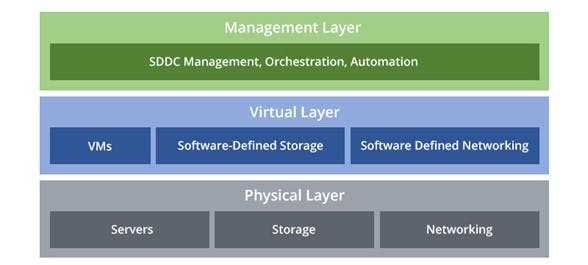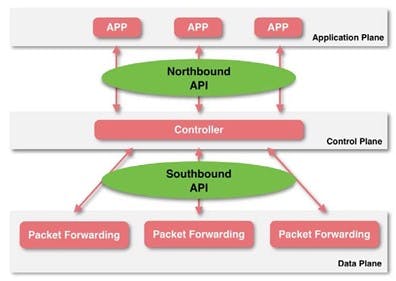Everything about SDDC
SDDC integrates virtualized infrastructure and simplifies resource provisioning and management.
Migrating to the Cloud has brought unprecedented flexibility to today's companies. However, since today's businesses use these benefits more, they risk creating unwanted complexity in the data center.
To solve this problem, SDDC integrates virtualized infrastructure and simplifies resource provisioning and management. When successfully implemented, it is an integrated architecture that considers and coordinates all essential components of the data center.

To understand the benefits and challenges surrounding SDDC, we need to consider how we got here
Traditional Data Center vs Virtualization:
In its old form, the data center consists of three pillars of IT infrastructure: computing resources, storage, and networking
Once upon a time, all three were physical resources that were often geographically co-located—for some organizations, this is still true. However, the vast majority of companies have moved at least part of their infrastructure to the cloud and Some of the resources are virtualized due to scalability, flexibility, and cost-effectiveness. Today, virtual resources may take many forms.
SDDC Architecture:
The SDDC architecture represents a complex approach to data center management and has multiple layers that focus on different functions.

Physical layer: Computing, storage, and network devices in the data center are placed in this layer. This layer focuses on the performance and operational stability of the devices and provides a stable environment for the entire network and SDDC business operations.
Virtual layer: Controls access to the physical infrastructure and segregates resources to provide them as services. It is also responsible for monitoring network operations and resource allocation, simplifying data center management, and improving efficiency.
management layer: standardizes management and enables orchestration and automation capabilities, allowing SDDC to be controlled from a central point.
To better understand SDDC, it is better to learn more about the concepts of SDN and SDS.
SDN:
SDN stands for Software Defined Network, a network architecture approach that enables network control and management using application software. The network behavior of the entire network and Software Defined Network (SDN) through its devices are programmed in a centrally controlled manner through software using available APIs.
To understand Software Defined Network we need to understand the different levels involved in the network. These levels are:
Data plane
Control Plane
DataPlane:
All activities related to data packets sent by the client are related to this section:
1. Sending packets
2. Division and re-collection of data.
3. Repetition of packets for multicasting
Control Plane:
All activities necessary to perform Data Plane activities except for client data packs. In other words, it is the brain of the network that includes:
1. Create routing tables
2. Setting policies for packet management
SDN Importance:
1. Better network connectivity: SDN provides much better network connectivity for sales, service and internal communications. SDN also helps to share data faster.
2. Better deployment of programs: The deployment of programs, services, and many new business models can be increased by using Software Defined Networking.
3. Better security: SDN provides better visibility across the network. Operators can create separate zones for devices that require different levels of security. SDN networks give operators more freedom.
4. Better control with high speed: SDN provides better speed than other types of networks by using a software-based controller.
In short, it can be said that SDN acts as a larger umbrella or a Hub where the rest of the network technologies come and sit under that umbrella and integrate with another platform to reduce traffic and increase the efficiency of data flow, the best result.
Where is SDN used?
Companies use SDN to deploy applications faster while reducing deployment and operational costs. SDN allows network administrators to manage and deliver network services from a single location.
SDN components:
The three main components that make up SDN are:
SDN programs: SDN programs send requests or networks through the SDN Controller using API.
SDN Controller: SDN Controller collects network information from hardware and sends this information to applications.
SDN network devices: SDN network devices help in sending and processing data
SDN architecture:
In an old network, each switch has its data plane and control plane. The control plane exchanges the topology information between the various switches and thus creates a forward table that decides where the incoming data packet should be forwarded through the data plane.
SDN is an approach through which we separate the Control Plane from the switch and assign it to a centralized unit called the SDN Controller. In this way, the network admin can shape the traffic through the central console without having to access the switches.
The data plane also resides in the switch, and when a packet enters a switch, its forwarding activity is determined based on table entries, which are pre-defined by the controller.

A typical SDN architecture consists of three layers.
Application layer: includes common network applications such as intrusion detection, firewall, load balancer, etc.
Control layer: includes the SDN Controller, which acts as the brain of the network. It also allows hardware separation for programs written on top of it.
Infrastructure layer: This layer includes the physical switches that form the data plane and perform the actual movement of data packets.
The layers communicate through sets of connections called (north-bound API between the application and control layer) and (southbound API between the control and infrastructure layer)
SDS:
Software-defined Storage or SDS is a storage architecture that separates the storage software from its hardware. Unlike legacy storage systems such as network-attached storage (NAS) or storage area network (SAN), SDS is generally designed to run on any industry-standard or x86 system, eliminating software dependency on proprietary hardware.
Advantages of SDS:
1. The SDS you choose should not be from the same company that sold you the hardware. You can use any x86 commodity or server to create an SDS-based storage infrastructure. This means you can maximize the capacity of your existing hardware as your storage needs increase.
2. SDS allows you to adjust the capacity and performance completely independently, according to the needs of the organization.
3. SAN storage devices are limited to the number of nodes they can use. SDS, by its very definition, is not limited in this way and is theoretically infinitely scalable.
Advantages of Software-Defined Data Center:
Based on unique features, Software-Defined Data Center enables organizations to achieve more flexible and faster deployment, management, and business implementation at lower cost.
Business agility:
With infrastructure management, automation, and service orchestration functions, SDDC removes the physical dependency of hardware and enables real-time provisioning of resources, which can manage workloads and respond quickly to business demands.
In fact, the time of deployment and provision of resources can be significantly reduced and it does not take much time to provide more storage capacity for applications and modify the physical network.
Increased scalability:
Cloud-based SDDC allows organizations to scale up or down performance as needed to meet changing demand. Increasing or decreasing IT resources, such as data storage capacity, and network processing power, is very simple. SDDC offers unlimited scalability. No need to worry about freeing up more space to meet growing business needs.
Reduce costs:
SDDC can help reduce costs. Older data centers require more IT manpower, expensive equipment, time, and maintenance. While in SDDC they can avoid large capital costs. For example, the SDDC pools resources to improve infrastructure utilization and reduce the cost of purchasing new infrastructure. Better utilization also means lower costs for electricity, cooling, etc.
Simple data center management:
SDDC can be managed through a central dashboard, allowing network administrators to monitor data, update systems, and allocate additional storage resources. Compared to legacy data centers, which may require multiple IT tools, applications, and software to manage, SDDC makes data center management much simpler.

